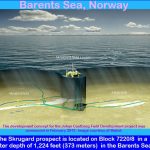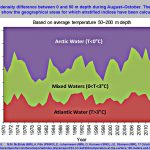Posted: 03 June 2016
Barents Sea a key issue to Arctic warming
Since January 2016 Arctic sea ice extent is far below average (Fig. 1). Arctic sea ice could set a new record low extent this
summer, and the Barents Sea is one of the main sources to blame (Fig. 2), due to the fact that along the Norwegian coast , in the Barents Sea and north of the Russian coast human offshore activities steadily increase year by year.
What’s behind this winter’s low ice extent? The Arctic is warming more than twice as fast as the global average, largely in response to rising greenhouse gases, assumes a recent report (HERE-1), which is pure guessing. Another source must drive the warming, for example dozens of human activities at the sea surface and below the sea surface down to the sea bottom. Particularly the off-shore installation that stretch over several hundred meters, form a formidable resistance to flowing water, by changing the water structure concerning temperatures and salinity. The last year record low is discussed HERE-2. The post clearly points to a significant anthropogenic relevance, not via the air, but via the sea.
 |
 |
 |
Credit and Source: Arctic sea ice record low – 02/25/2015 – Post 17. April 2015 |
||
Three recent essays by McBride and colleagues, October 2015 (HERE-3; HERE-4, HERE-5) confirm positive surface water temperature anomalies prevailed in the Barents Sea. According their research the area of Atlantic Water and mixed water has increased in past decades, whereas that of Arctic water has decreased (Fig-3) (based on average temperature 50-200 m depth).
What they do not tell were the change is coming from. It could be either solely from the inflow from the North Atlantic, from the Arctic, originates from sea water mixing due to industrial operations, or via the atmosphere and/or sun. The latter is by far the most unlikely source, as the Barents Sea, is well above average summer and winter since long. The excess Arctic warming is an ocean matter. Presumably it may be a mix based on water inflow and various mixing mechanism due to industrial use of the Barents Sea. Whether the latter is minor, reasonable or very significant , is impossible to discuss, as not only any research is missing in this respect, but it lacks even the understanding that this aspect must not be ignored, but is a core issue for understanding higher than global average warming in the Arctic.
Also Ron Clutz (HERE-6) agrees with the conclusion (HERE-2):
“The recent new Arctic sea ice record gives little reason for lamenting, but should be seen as an opportunity to investigate and understand the human activities in the Barents and Okhotsk Sea. It could be observed that both seas differed most from average due to warmer sea water temperature. Although it may be difficult to assess the impact of worldwide shipping and fishing on climatic changes and ‘global warming’, it is a much lower challenge if only the impact of two regional seas, representing only about 1% of the global water surface, is investigated.” http://www.ocean-climate-law.com/13/Arch/5.html
HERE-1: http://www.carbonbrief.org/analysis-the-highly-unusual-behaviour-of-arctic-sea-ice-in-2016
HERE-2: http://www.ocean-climate-law.com/13/Arch/5.html
HERE-5: http://www.barentsportal.com/barentsportal/index.php/en/sport/24-cricket/261-currents-and-transport
HERE-6: https://rclutz.wordpress.com/2015/04/18/okhotsk-barents-who-cares/




Hi mates, pleasant piece of writing and nice urging commented
here, I am in fact enjoying by these.
This really answered my problem, thank you!
EXCEPTIONAL Post.thanks for share..more delay.